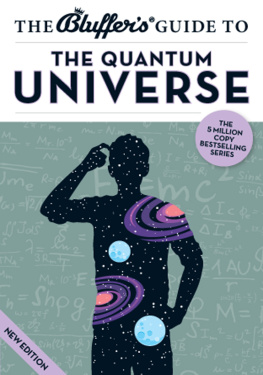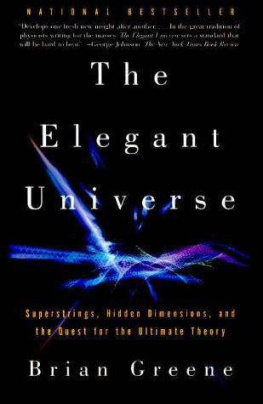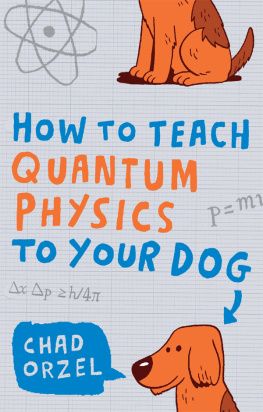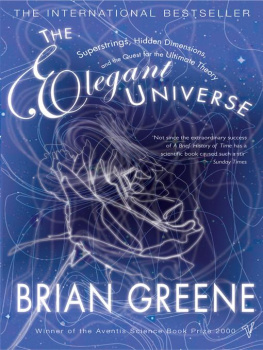

Hammersley House
5-8 Warwick Street
London W1B 5LX
United Kingdom
Email:
Website: bluffers.com
Twitter:
First published 1985
This edition published 2013
Copyright Bluffers 2013
Publisher: Thomas Drewry
Publishing Director: Brooke McDonald
Series Editor: David Allsop
Design and Illustration: Jim Shannon
All rights reserved. No part of this publication may be reproduced, stored in a retrieval system or transmitted in any form or by any means, electronic, mechanical, photocopying, recording or otherwise, without the prior permission of Bluffers.
A CIP Catalogue record for this book is available from the British Library.
Bluffers Guide, Bluffers and Bluff Your Way are registered trademarks.
| ISBN: | 978-1-909365-76-6 (print)
978-1-909365-77-3 (ePub)
978-1-909365-78-0 |

Nothing conveys the impression of substantial intellect so much as even the sketchiest knowledge of quantum physics.

LETS GET QUANTUM PHYSICAL
W hether you are trying to explore the universe, which is very, very big, or the quantum realm, in which particles of light and matter are very, very small, nothing can be stated with clearer conviction than this: nobody really understands whats going on. So, if you have ever lamented your own incomprehension, let yourself off the hook immediately. Welcome to a bluffers paradise, where no one need feel afraid, nor should anyone feel stupid.
Of course, where physicists do have knowledge and understanding, prudence dictates that astute bluffers gain some appreciation of it. This will not be too difficult. The universe is, after all, very large, and the smallest entities are extremely small and their conduct is unusual, to say the least.
Happily, such an appreciation may be obtained without formulas, equations or fractions. It may seem to be taking the word appreciation too far, but you are going to have to feign, find or affirm some sense of wonder. Nature is full of marvels at the best of times. In the quantum realm, as the great Danish physicist, Niels Bohr, used to say: if people didnt find these phenomena shocking, wild and confusing, they werent taking it in.
And Bohr was understating it, of course. Indeed, however bizarre a description of subatomic phenomena may be, therell always be some smarty-pants saying: Thats underselling it. Agree fervently and move on.
So, needless to say, overwhelming questions will continually come up. Nowadays these can be neatly batted away with the words: Yes, well, of course theyre looking into that at Cern. You hint at deeper knowledge by saying that Cern is an acronym for Conseil Europen pour la Recherche Nuclaire and by being specific about the actual location of the famous collider near Geneva, beneath the Franco-Swiss border. Not too far away from Goldfingers lair in the eponymous Bond book, actually.
Mentioning Cern will become an automatic response for you, and one that falls somewhere between They deal with that in accounts, Give the ball to Brian, and Do you mind if I have another glass of wine? No one should ever tire of saying, Yes, theyre addressing that at Cern.
Nothing conveys the impression of substantial intellect so much as even the sketchiest knowledge of quantum physics, and since the sketchiest knowledge is all anyone will ever have, never be shy of holding forth with bags of authority about subatomic particles and the quantum realm without having done any science whatsoever.
After all, what else is the act of bluffing about?
This book sets out to guide you through the main danger zones encountered in discussions about the quantum universe, and to equip you with a vocabulary and an evasive technique that will minimise the risk of being rumbled as a bluffer. It will lend you a few easy-to-learn hints and methods that will allow you to be accepted as a physics expert of rare ability and experience. But it will do more. It will give you the tools to impress legions of marvelling listeners with your knowledge and insight without anyone discovering that before reading it you didnt know the difference between a boson and a hadron, or, indeed, a fermion or a meson, or come to that a photon, pion or gluon. Time to put a smileon, get ready to putiton and readon.

The Italian physicist Enrico Fermi said that if he could remember all the names given to particles he would have been a botanist, and if such things really do interest you, you need to get out more.

PREPARING YOURSELF
DOES SIZE MATTER?
Whichever way you approach discussions about the universe and the quantum realm, the notion of scale will somehow always be present. But remember that it should be beneath you to be impressed by size; it is for other people to reel and gasp. Scale is something with which you must appear to be comfortable and familiar.
Physicists naturally possess what bluffers must somehow acquire: the ability to drop phenomenally massive numbers into the conversation with ease, airily disparaging geewhizzery while trotting out unimaginably awe-inspiring facts and figures.
Where the tendency is towards big, you need to appreciate that a light year measures the distance you could cover in a Julian year (thats a normal calendar year of 365.25 days), zooming at 186,283 miles per second. The nearest galaxy to earth, newly discovered, is a trillion miles away remarkably near as galaxies go, but still pretty far, even for a commercial traveller. (And if you do go, dont talk to strangers.)
At the other extreme, you need to have some idea of what is meant by small. All matter can be broken down into atoms. Atoms are small. They are smaller than affordable apartments in Manhattan, they are smaller than average portions at The Ritz, they are even smaller than the chance that a politician will give you an honest answer. The full stop at the end of this sentence will be a tiny blob of ink about a quarter of a millimetre wide which will contain close to four billion atoms.
Having taken that into account, a reminder is necessary. To a human being, or to a full stop, an atom is small. But to a subatomic particle, any one of those four billion atoms in that full stop is enormous.
At the centre of an atom is a nucleus itself made of particles. The nucleus feels within the atom as a regulation red ball might feel in a cricket ground. The electrons that surround the atom would be akin to peanuts circling at the outskirts of the grounds car park. There are no players, spectators or refreshment-sellers around. Atoms are usually described as being made up of 99.9999999999999% empty space. Without that empty space, the entire human race would fit into a space the size of a sugar cube.
Pointing to such a cube, or mentioning how many atoms there are in a grain of coffee, or Parmesan cheese, or beach sand, or, best of all, in a pretty freckle on human skin, may be a game well worth the candle for the confident bluffer. But you can take it further.
Next page
















